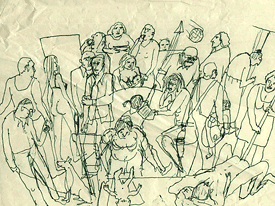Although we've seen this effect used since The Matrix in numerous advertisements, films and spoofs, this example reveals in its reduced, contemporary aesthetics the object-oriented nature of the hypercubist revolution on its way. The subtle interplay of the different players in this "time sculpture" (as the ad agency people call it) reveals the short-comings of 2D compositing while also hinting at an entirely different image world.
Of course my contention is that the methodology used in this process is already theoretically obsolete. I predict that the scanning technologies of the future should be able to yield clouds of photo-realistic data without the necessity of 200 distinct video cameras. Nonetheless, state-of-the-art Californian motion capture company MOVA is also using a highly complex strobing multi-camera system together with phosphorescent makeup.
Their white paper on volumetric cinematography is a great quick read, written in accessible, non-scientific language, and resonates strongly with my own hypercubist theory.
These developments surely must be fascinating for the early pioneer of blue-screen proto-hypercubism, Zbig Rybczynski. His 1980 film Tango was an essential forerunner of such object oriented imagery.
The concept sketches, diagrams and film still from the finished composite of Tango reveal a direct hand-crafted analog predecessor of the Toshiba spot;








No comments:
Post a Comment